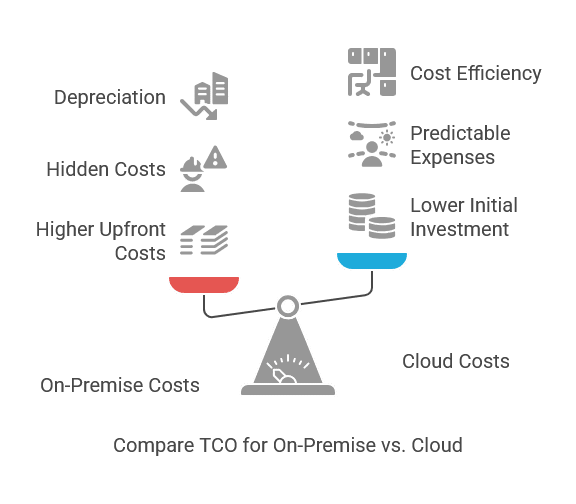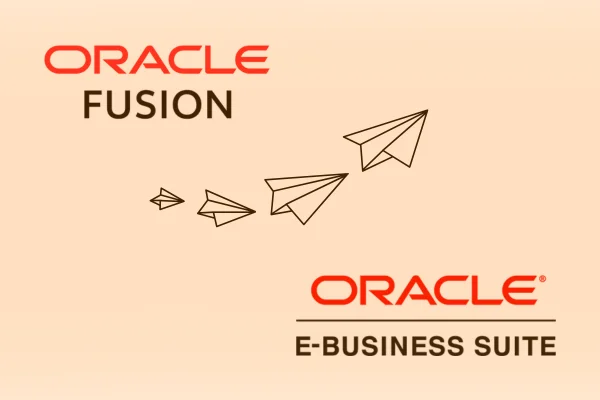Table of Contents:
When considering Oracle on-premise vs cloud solutions, organizations are faced with the decision of whether to keep their systems on-premise or migrate to the cloud. While the initial cost comparison between the two options may seem clear, there are hidden costs in both approaches that must be carefully evaluated.
Understanding these costs can help businesses make more informed decisions that align with their long-term goals.
Oracle On-Premise vs Cloud: Infrastructure and Hardware Costs
On-Premise Costs:
- Capital Investments: Significant upfront costs for servers, storage, and network infrastructure.
- Ongoing Expenses: Power, cooling, and facility costs for data centers. Maintenance of hardware requires periodic upgrades and replacements.
- Redundancy and DR: Additional costs for backup infrastructure and disaster recovery solutions.
Cloud Costs:
- No Physical Hardware: Cloud removes the need for data center ownership or physical infrastructure investments.
- Operational Expenses: Costs shift to a pay-as-you-go subscription model, where businesses pay only for what they use.
Scalability: Cloud providers handle infrastructure scaling, reducing the need for overprovisioning.
Learn more about how you can make the most of your Oracle experience:
Oracle On-Premise vs Cloud: Licensing and Software Costs
On-Premise Costs:
- Upfront Licenses: Significant one-time costs for purchasing Oracle licenses.
- Annual Support Fees: Ongoing costs (typically 22% of the license cost) for software updates and vendor support.
- Additional Licensing Costs: Licensing for additional modules or users as the business grows.
Cloud Costs:
- Subscription Model: Pay for software as part of the subscription, often inclusive of updates and support.
- Flexible Licensing: Cloud offers pay-per-use pricing and allows for scaling licenses up or down as needed.
Oracle On-Premise vs Cloud: Staffing and Operational Costs
On-Premise Costs:
- IT Staffing: Requires a dedicated team of administrators and engineers for system maintenance and troubleshooting.
- Training and Expertise: Investment in training staff to manage hardware, updates, and infrastructure.
Cloud Costs:
- Reduced Staffing Needs: Cloud providers handle much of the routine maintenance, allowing IT staff to focus on higher-value activities.
- Skill Set Shifts: Cloud adoption may require training for new skills (e.g., cloud architecture), but reduces the need for traditional hardware management expertise.
Oracle On-Premise vs Cloud: Maintenance and Upgrades
On-Premise Costs:
- Maintenance Burden: The responsibility for patching, upgrading, and hardware maintenance falls on the organization.
- Upgrade Costs: Major version upgrades require significant resources and downtime, often incurring additional consulting fees.
Cloud Costs:
- Automatic Updates: Providers handle regular updates and patching, ensuring systems are always up to date.
- No Downtime: Cloud environments often include seamless updates with minimal impact on business operations.
Oracle On-Premise vs Cloud: Security and Compliance
On-Premise Costs:
- Security Investment: Requires dedicated security infrastructure, monitoring, and compliance management.
- Audit and Compliance Costs: Regular audits and certifications require significant resources to manage and maintain.
Cloud Costs:
- Built-in Security: Cloud services come with built-in security features and compliance certifications.
- Shared Responsibility: While the cloud provider manages infrastructure security, businesses must ensure data security and access controls.
Oracle On-Premise vs Cloud: Total Cost of Ownership (TCO)
On-Premise Costs:
- Higher Upfront Costs: On-prem systems require large capital investments and ongoing maintenance expenses.
- Hidden Costs: Costs such as energy, staffing, and hardware failure are often underestimated.
- Depreciation: Hardware and software investments depreciate over time, requiring further investment for system refreshes.
Cloud Costs:
- Lower Initial Investment: The cloud model offers reduced upfront costs with a subscription-based pricing structure.
- Predictable Expenses: Ongoing costs are more predictable, with no large capital investments required.
- Cost Efficiency: Cloud systems can achieve lower long-term TCO through optimized resource usage and reduced overhead.
Conclusion
Choosing between Oracle cloud vs on premise solutions requires more than a simple cost comparison. While on-prem deployments may seem more cost-effective upfront, the hidden costs associated with infrastructure, licensing, maintenance, and staffing can add up over time.
Cloud solutions offer a more flexible, scalable, and cost-efficient model, especially for businesses seeking to reduce overhead and optimize operational resources.
If you’re evaluating the best approach for your Oracle systems, reach out to Vigilant Technologies for a comprehensive Oracle cost assessment.
Our experts can help you navigate the complexities of both Oracle on premise vs cloud options, ensuring you make a decision that aligns with your organization’s goals and drives long-term success.
Contact us to schedule your consultation today.







